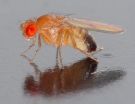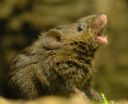(Press-News.org)
VIDEO:
This video features an interview with Tim Karr, a researcher at the Biodesign Institute at Arizona State University.
Click here for more information.
The propagation of every animal on the planet is the result of sexual activity between males and females of a given species. But how did things get this way? Why two sexes instead of one? Why are sperm necessary for reproduction and how did they evolve?
These as-yet-unresolved issues fascinate Timothy Karr, a developmental geneticist and evolutionary biologist at Arizona State University's Biodesign Institute. To probe them, he uses a common fruit fly, Drosophila melanogaster—an organism that has provided science with an enormous treasure-trove of genetic information.
"My research focuses on the evolution of sex and in gamete function," Karr says. "I focus primarily on the sperm side of the sexual equation. I'm interested in how they originated and how they are maintained in populations."
Karr's current study, in collaboration with researchers at the University of Chicago, recently appeared in the journal BMC Biology. The study reexamines an earlier paper that analyzed the sex chromosomes of fruit flies during spermatogenesis—the process that produces mature sperm from germ cells.
While the previous paper, by Lyudmila M Mikhaylova and Dmitry I Nurminsky, argued against the silencing of sex-linked genes on the X chromosome in Drosophila during meiosis—a process referred to as Meiotic Sex Chromosome Inactivation (MSCI) —the reanalysis presented by Karr suggests MSCI is indeed occurring.
The work sheds new light on the evolution of sperm structure and function, through an analysis of Drosophila genes and gene products. As Karr explains, the research has important implications for humans as well: "The more direct, biomedical aspect is that when we learn about the function of a gene that encodes a protein in Drosophila sperm, we can immediately see if there's a relationship between these genes and their functions and known problems with fertility in humans."
Super Fly
Perhaps no other model organism has yielded more insights into human genetics than the tiny fruit fly Drosophila melanogaster. In 1906, Thomas Hunt Morgan of Columbia University began work on D. melanogaster, (one of over 1500 species contained in the Drosophila genus) capitalizing on the species' ease of breeding, rapid generation time and ability to readily produce genetic mutants for study. Morgan's efforts with Drosophila led to the identification of chromosomes as the vector of inheritance for genes, and earned him the 1933 Nobel Prize in Medicine.
Drosophila are yellow-brown in color, have reddish eyes and transverse black rings across their abdomen (see Figure 1). Females are about 2.5 millimeters long, while males are slightly smaller and may be easily identified by their darker color.
Most importantly, the similarity in the genetic systems of fruit flies and other eukaryotic organisms including humans makes these model organisms extremely useful analogues for the study of common genetic processes including transcription and translation.
Roughly 75 percent of known human disease genes have recognizable correlates in the fruit fly genome and 50 percent of fly protein sequences have mammalian homologs. (The complete genome of D. melanogaster was completed in 2000.)
Chromosomes: genetic storehouses
Humans have 23 pairs of chromosomes, or 46 chromosomes in all. Of these, 44 are known as autosomes and consist of matched pairs of chromosomes, known as homologous chromosomes. Each homologous chromosome contains the same set of genes in the same locations along the chromosome, though they may appear in differing alleles, which can affect the passing of genetic traits.
The current study however, focuses not on the autosomes but on the remaining pair of chromosomes, known as sex chromosomes. Females contain two X chromosomes, which are homologous, as in the case of the autosomes. By contrast, males are identified as having one X chromosome and one (much smaller) Y chromosome.
While drosophila only have a total of 4 chromosomes, they too display sexual dimorphism, with females carrying the double X chromosomes and males carrying XY. The two X chromosomes in female fruit flies, as in mammals, make them a homozygous sex as compared with the XY condition in males, known as heterozygous.
"There are certain aspects to the composition of these sex chromosomes that have intrigued evolutionary biologists for a long time," Karr notes. One such issue involves an apparent reduction in the number or the level of expression of sex-linked genes on the X chromosome during spermatogenesis. It is believed that this reduction or silencing of genes on the X chromosome may have profound implications for the evolution of sex chromosomes.
During meiotic development of a sperm cell, nature attempts to compensate for the fact that females have two X chromosomes and therefore enjoy a numbers advantage in terms of genes, compared with males. To overcome the bias for female X-linked genes, the X chromosome undergoes inactivation during meiotic sexual differentiation of male gametes, resulting in an underrepresentation of sex-specific genes on the X chromosome. Some of these genes, which may be beneficial to males, are moved from the X chromosome, to the autosomes, where they may be expressed.
The relocation of male-biased genes to the autosomes may be due to a selective advantage favoring genes that move off the X chromosome and therefore avoid X-inactivation during meiosis. Such theories remain controversial however, as statistical analyses are used to evaluate gene frequencies and expression levels, making the proper categorization of genes particularly challenging. "The data we create and generate to support our ideas and hypotheses are messy, there's noise in them," Karr says. "Such noise is inherent in the history of evolution."
In addition to the steady stream of insights into chromosome evolution, Drosophila are being used as a genetic model for a variety of human diseases including Alzheimer's, neurodegenerative disorders, Parkinson's, Huntington's, as well as extending knowledge of the underlying mechanisms involved in aging, oxidative stress, immunity, diabetes, and cancer.
INFORMATION:
Written by:
Richard Harth
Science Writer: The Biodesign Institute
richard.harth@asu.edu
Study of fruit fly chromosomes improves understanding of evolution and fertility
2012-08-11
ELSE PRESS RELEASES FROM THIS DATE:
Researchers develop new physical face cloning method
2012-08-11
ZURICH – Animatronics aims at creating physical robots that move and look like real humans. Many impressive characters have been created in this spirit, like those in the Hall of Presidents attraction at Walt Disney World. Until now, creating animatronic copies of real human individuals is a difficult and labor-intensive process requiring the manual work of skilled animators, material designers and mechanical engineers. Researchers at Disney Research, Zürich, ETH Zürich, and Walt Disney Imagineering R&D have developed a new computational design process for cloning human ...
Researchers invent system for 3-D reconstruction of sparse facial hair and skin
2012-08-11
ZURICH – Researchers at Disney Research, Zürich, ETH Zürich, and Cornell University have invented a system to digitize facial hair and skin. Capturing facial skin and geometry is a fundamental technology for a variety of computer-based special effects for movies. Conventional face capturing is well established and widely utilized in the entertainment industry to capture a three-dimensional model of an actor's face. However, up to now, no method was capable of reconstructing facial hair or even handling it appropriately. This omission is surprising as facial hair is an important ...
NASA sees tropical cyclones march across Atlantic: Ernesto, Florence, TD7, System 92L
2012-08-11
Four tropical systems are marching across the Atlantic Ocean basin on August 10, 2012. NASA's GOES Project, located at NASA Goddard Space Flight Center in Greenbelt, Md. has been busy creating images and animations of the four tropical cyclones, Ernesto, the remnants of Florence, Tropical Depression 7, and System 93L.
NASA's GOES Project uses data from NOAA's Geostationary Operational Environmental Satellites (GOES), and the GOES-13 satellite covers the Atlantic Ocean basin and the eastern U.S. from a fixed orbit. GOES-13 provides continuous data that NASA makes into ...
NASA sees 2 tropical cyclones in Eastern Pacific
2012-08-11
The Atlantic Ocean hurricane season is in full swing and the Eastern Pacific seems like it's trying to catch up. On August 10, NOAA's GOES-15 satellite captured Tropical Storm Gilma and a low pressure area that was once the Atlantic Basin's Tropical storm Ernesto, now moving off the western Mexican coast.
NASA's GOES Project, located at NASA Goddard Space Flight Center in Greenbelt, Md. has been busy creating images and animations of Tropical Storm Gilma and the remnants of Tropical Storm Ernesto as it crosses Mexico from the Gulf of Mexico and has begun its entrance ...
Of mice and melodies
2012-08-11
Singing mice (Scotinomys teguina) are not your average lab rats. Their fur is tawny brown instead of the common white albino strain; they hail from the tropical cloud forests in the mountains of Costa Rica; and, as their name hints, they use song to communicate.
University of Texas at Austin researcher Steven Phelps is examining these unconventional rodents to gain insights into the genes that contribute to the unique singing behavior—information that could help scientists understand and identify genes that affect language in humans.
"We can choose any number of traits ...
Prenatal whole genome sequencing: Just because we can, should we?
2012-08-11
(Garrison, NY) With whole genome sequencing quickly becoming more affordable and accessible, we need to pay more attention to the massive amount of information it will deliver to parents – and the fact that we don't yet understand what most of it means, concludes an article in the Hastings Center Report. The authors are current or former scholars at the National Institutes of Health's Department of Bioethics.
Most analyses of the ethical issues raised by whole genome sequencing have been "futuristic forecasting," but the authors conclude that "this is problematic given ...
Bell Nunnally Adds Jeffrey Ansley
2012-08-11
Bell Nunnally & Martin LLP (www.bellnunnally.com) has added Jeffrey J. Ansley as a partner and member of the firm's Litigation and White Collar Defense and Internal Investigations practices. Ansley joins the firm from Curran Tomko Tarski LLP in Dallas.
"Jeff is a great addition to the firm. Our clients will benefit from his expertise and his experience as a former federal criminal prosecutor and enforcement attorney," said James Skochdopole, managing partner of Bell Nunnally.
Ansley serves as defense and trial counsel for clients in complex criminal ...
XenSummit 2012 Agenda and Speaker Line-up
2012-08-11
Xen.org, home of the open source Xen hypervisor, today announced the final speaker line-up and agenda for its annual Xen Summit North America conference. The event will be held, August 27-28 in San Diego, California and is co-located with CloudOpen and LinuxCon North America.
XenSummit attracts prominent Xen community members and thought leaders from around the world to hear updates on future plans, research and new developments for technologies based on the Xen Hypervisor, as well as discuss the current state of projects applying Xen technology to areas like cloud computing, ...
Saint Joe: Delivering the Finest Roasted Coffee Beans Right at Your Doorstep
2012-08-11
Saint Joe, an Australia-based online coffee bean retailer, continues to seek ways to provide their customers only the finest coffee beans roasted in Australia. With the launch of Saint Joe's new website, coffee lovers can now create their perfect cup of coffee without the hassle of purchasing low-grade beans from supermarkets or direct coffee roasters. They can simply log on to http://www.saintjoe.com.au and choose among Saint Joe's collection of high quality coffee beans.
Embracing the belief that life is too short to drink bad coffee, Saint Joe strives to offer premium ...
Total Wine & More Introduces Next-Generation Retail Experience In New Southern California Store
2012-08-11
Total Wine & More, America's largest independent retailer of fine wine, spirits and beer, will introduce its new, "next-generation" retail experience in Southern California with the opening of its latest location in Laguna Hills, Calif. on August 16.
The beverage superstore has created a unique retail environment centering around the latest technologies to enhance its customers' experience, according to David Trone, co-owner of Total Wine & More. Next-generation elements include iPads which allow customers to interact with an app that recommends wine ...



